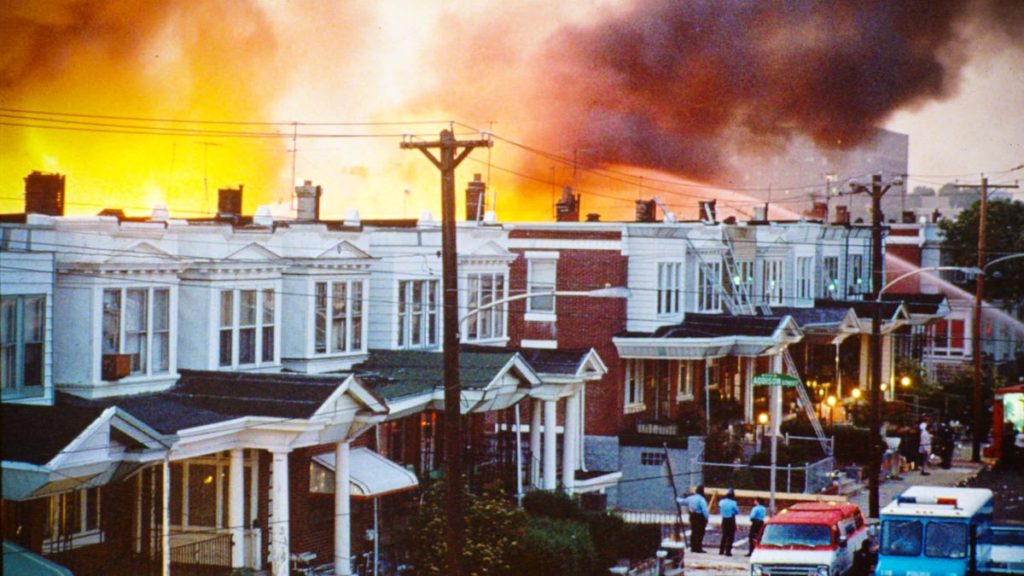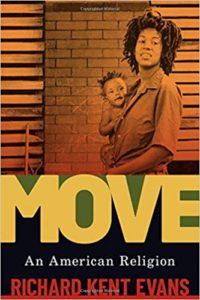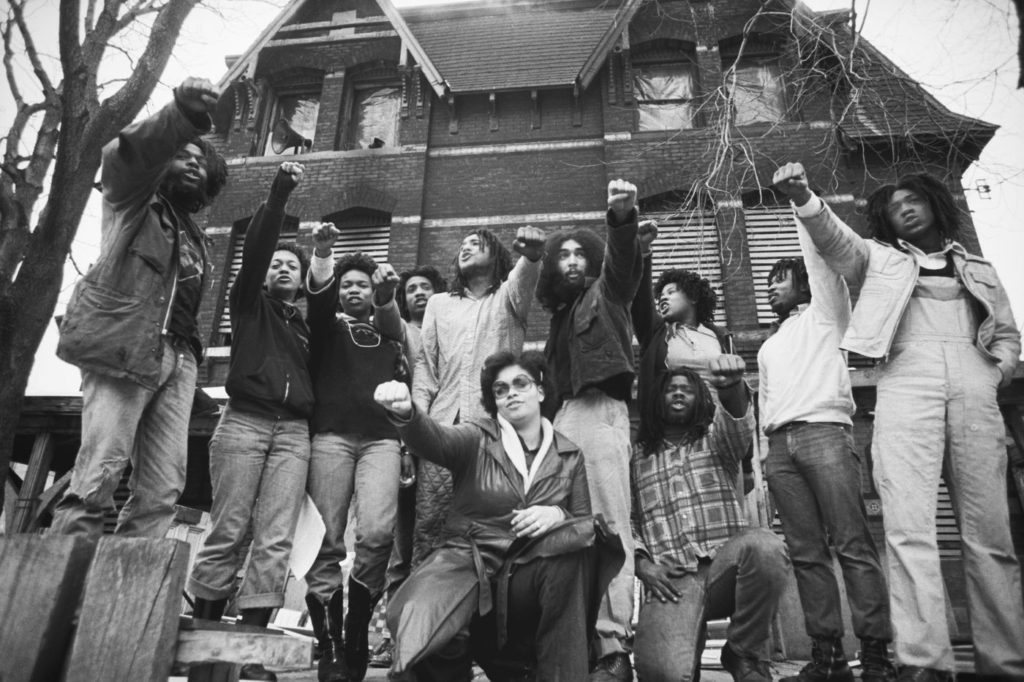Bombing American Religion to Save It
A Review of Richard Kent Evans’s book MOVE: An American Religion

(Homes burn in Philadelphia after the police dropped a bomb on the MOVE headquarters. Photo courtesy of Associated Press.)
Richard Kent Evans had me at “there is, to be clear, no such thing as a cult.”
In this groundbreaking book, MOVE: An American Religion, Evans insists that “cult” refers to the following:
“A way of policing the boundaries of the category of religion, of deciding which beliefs and practices are legitimate and which are not. We call groups ‘cults’ if they seem to be too controlling — as if real religions are defined by individual autonomy and free agency. We call groups “cults” if they strike us as especially dangerous — as if real religions do not engage in violent or threatening behavior. We call groups ‘cults’ if their teachings seem outlandish — as if real religions are true.”
 In his analysis of MOVE, a Black religious movement that the Philadelphia Police Department bombed in 1985, Evans shows us in excruciating detail how violently Americans construct and constrain what counts as legitimate religion. His book forces us to consider what happens when a religion’s teachings feel too outlandish, when a group’s dynamics seem dangerous, when a member’s actions or thoughts appear too shaped by a community’s commitments. Through his analysis of the history, theology, and fate of MOVE, Evans illustrates how such a religion, group, or community gets labeled a cult.
In his analysis of MOVE, a Black religious movement that the Philadelphia Police Department bombed in 1985, Evans shows us in excruciating detail how violently Americans construct and constrain what counts as legitimate religion. His book forces us to consider what happens when a religion’s teachings feel too outlandish, when a group’s dynamics seem dangerous, when a member’s actions or thoughts appear too shaped by a community’s commitments. Through his analysis of the history, theology, and fate of MOVE, Evans illustrates how such a religion, group, or community gets labeled a cult.
Against Cults: How Not to Define American Religion(s)
I have done much public yelling on the subject of cults, a propensity to which anyone who follows me on Twitter can attest. The problem of calling something a “cult” is legion, but my primary objections to the term are threefold:
1) Cult = religion you don’t like
In what is now the United States, people use cult as a shorthand for what they perceive as religion done “wrong.” This usage smuggles in numerous assumptions about what religion done right should look like, and it just so happens religion “should” look like moderate white Christianity. We see this played out in courts, prisons, hospitals, popular media, and countless other places. In the case of MOVE, its members saw it as a religious community. But within Philadelphia’s legal and policing systems, MOVE was only ever a cult. As MOVE member Gerald Africa attested, “they [Philadelphia law enforcement, government officials, and the judicial system] just spit all over our religion like our religion didn’t count.”
2) Cult = predatory, abusive, irrational behaviors and practices
People aren’t always referring to explicitly religious practices or beliefs when they use the word cult, but they are building on the word’s religious genealogy. Historically, the term cult has been used to describe groups that people believe have exploited America’s professed commitment to religious freedom (terms and conditions may apply) to harm, mislead, violate, and/or fleece the more vulnerable and feeble-minded among us.
It is no accident, then, that countless Black-led religious innovations, women-led religious innovations, and especially Black women-led religious innovations have been criticized as cults. Non-white non-men who join these groups are often seen as less rational, weaker, and thus more susceptible to religious, as well as economic and sexual, manipulation. As Evans shows, critics attempted to discredit MOVE by accusing founder John Africa and his community of being abusive, disingenuous, irrational, and exploitative of the women and children in the community.
3) “Cult” = dangerous
Rather than confront abuse as endemic to American culture, “cult” makes abuse an issue of religion-done-wrong. The problem becomes specific religions, not abuse; and the solution is to insist that religion be done right (e. in ways approximating moderate white mainstream Christianity) or not at all. We say “cult” when we mean “dangerous religion,” and continuing to describe groups that make us uncomfortable as cults reinforces this distinction and the white supremacist, sexist, Christian imperialist assumptions it implies.
Labeling a group or organization a “cult” has justified state surveillance, law enforcement violence, and many, many violations of Americans’ civil rights. “Cult” gets used to mark certain groups as too different to be included in America’s alleged promise of religious freedom. Throughout the 20th century, whites censored, vilified, and punished Black religious innovators and resistance groups by labeling them “cults.”
The state-sanctioned immolation of MOVE’s home is among the starkest and most gruesome annihilations of a so-called cult in the United States. Evans’s chronicle of MOVE’s history is both sorely needed and hauntingly timely.
Who Were MOVE?
MOVE: An American Religion is, to the best of my knowledge, the first and only monograph-length treatment of the group John Africa founded in 1972 as the Christian Movement for Life. MOVE wanted to live and raise their children in their best understanding of their natural world. Members signaled their commitment to a natural lifestyle by taking the surname Africa, in connection with the continent they called Mother. They resisted technology, medical science, and “progress” as unnatural and unhealthy, especially for Black people.

(Photo of MOVE members. Photo by Leif Skoogfors for Getty Images.)
At the time of MOVE’s founding, the state of North Carolina was still forcibly sterilizing Black women. The medical establishment consistently failed Black Americans; indeed, it continues to fail Black people today. Given these systemic racist problems, John Africa’s concerns were perhaps less radical and less irrational than Philadelphia law enforcement made them out to be, even as MOVE’s customs troubled their neighbors and provided a cover of excuses for police violence.
On May 13, 1985, Mayor Wilson Goode gave Philadelphia Police Commissioner Gregore Sambor permission to drop a makeshift bomb—an IED, one could say—on the building that was MOVE’s home. Flames quickly spread to adjoining rowhomes, and Sambor told firefighters to “let the fire burn.” Sixty-one houses were destroyed in the predominantly Black neighborhood of West Philadelphia; 250 people lost their homes. Police violence claimed eleven lives, including those of five Africa children.

(Photo of the bomb’s destruction. Photo by George Widman for Associated Press.)
University of Pennsylvania professor Alan Mann removed the remains of two of those children without MOVE survivors’ knowledge or permission from the city medical examiner’s office. Until April of this year, Penn Museum curator Janet Monge was using these children’s bones in a Princeton University online forensic anthropology course.
Princeton and the Penn Museum have since apologized for this desecration, for what it’s worth. It’s actually worth very little, especially following a Penn-funded independent investigation that condemned Mann and Monge for “extremely poor judgement and gross insensitivity,” but ultimately concluded neither anthropologist violated “any relevant professional, ethical, or legal standards.”
Given the infamy of other so-called cults’ demise—think Jonestown; think Waco; think Heaven’s Gate; the mental images are immediate, visceral, unsettling—it seems impossible that so violent and public a conflict could escape either public memory or academic scrutiny. And yet MOVE has largely done both until quite recently. Evans’s MOVE: An American Religion deftly blends the rich and largely overlooked history of John Africa’s family and the community he founded with a crucial theoretical intervention for how we think about religion, cults, and the space (if any) between the two.
Defining Religion
Through his painstaking engagement with MOVE’s history, Evans outlines the stakes of counting as a “real” religion in the United States. “Religion is a category of privilege, the ramifications of which, in MOVE’s case, were literally life and death,” he argues. We cannot understand MOVE as an organization or as a target of state-sanctioned violence if we do not account for religion’s weight, significance, and precarity.
MOVE had a sacred text, a prophetic and charismatic leader, an etiological worldview, and ritual practices; MOVE members called themselves a religion. Evans writes, “We see, in MOVE, people striving toward what they believed was a better world and grappling with what it means to be authentically human. We see the voiceless and the marginalized believing in their own agency. All of this — the pain and the joy, hypocrisy and commitment, violence and peace, despair and hope, life-giving and death-bringing — is precisely what religion is.”
But as Evans devastatingly illustrates, an American religion is defined not by its members but by its regulators. The bombing of MOVE’s home at 6621 Osage Avenue is best understood, he argues, “as the secular state preempting ‘illegitimate’ religious violence with ‘legitimate’ state violence.” In short: understanding MOVE as a cult, rather than as a religion, allowed Philadelphia officials to destroy the movement and murder several of its members with impunity. The homes of MOVE’s neighbors were collateral damage in a definitional war of religion.
***
“Cult,” as Princeton religion professor Judith Weisenfeld teaches us, says more about those who use the descriptor than about those so described. MOVE: An American Religion helps us see that “cult” represents not an empirical reality but a political battleground and a convenient vehicle for systemic racial and religious intolerance. Philadelphia law enforcement’s response to MOVE-as-cult tells us nominally secular institutions can, have, and will define and defend American religion in explosive, murderous ways. Evans’s evocative book denies us—as it should—any further claims to ignorance or indifference about the stakes of defining American religion.
Megan Goodwin is Program Director of Sacred Writes: Public Scholarship on Religion, co-host of Keeping It 101: A Killjoy’s Introduction to Religion Podcast, and the author of Abusing Religion (Rutgers 2020). Follow her on twitter @mpgphd.